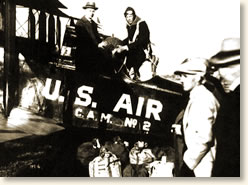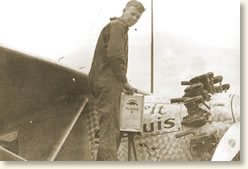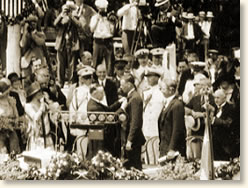|
Lindbergh Flies the Atlantic, 1927
At 7:52 A.M., May 20, 1927 Charles Lindbergh gunned the engine of the "Spirit of St Louis" and aimed her down the dirt runway of Roosevelt Field, Long Island. Heavily laden with fuel, the plane bounced down the muddy field, gradually became airborne and barely cleared the telephone
 |
Mail pilot Lindbergh loads his plane for
the first mail flight between St. Louis
and Chicago, 1925
|
wires at the field's edge. The crowd of 500 thought they had witnessed a miracle. Thirty-three and one half-hours and 3.500 miles later he landed in Paris, the first to fly the Atlantic alone.
Working as a mail pilot a year earlier he heard of the $25,000 prize for the first flight between New York and Paris. Backed by a group of St. Louis businessmen, Lindbergh supervised the building of his special plane and set out after the prize. Other teams were attempting the feat - some had met disaster. Lindbergh equipped himself with four sandwiches, two canteens of water and 451 gallons of gas. Midway through the flight "sleet began to cling to the plane. That worried me a great deal and I debated whether I should keep on or go back. I decided I must not think any more about going back."
On the evening of May 21, he crossed the coast of France, followed the Seine River to Paris and touched down at Le Bourget Field at 10:22P.M. The waiting crowd of 100,000 rushed the plane. "I saw there was danger of killing people with my propeller and I quickly came to a stop." He became an instant hero, "the Lone Eagle." New York City gave him the largest ticker tape parade ever, the president awarded him the Distinguished Flying Cross. His feat electrified the nation and inspired enthusiastic interest in aviation.
Bad weather and the prospect that his transatlantic flight would be delayed for a number of days greeted Lindbergh upon his arrival in New York. However, on May 19th, a favorable weather report predicted a break in the rain prompting Lindbergh to make his attempt the next day. He arrived at the airfield before dawn the next morning, prepared his plane for flight and began his historic journey:
"About 7:40 A.M. the motor was started and at 7:52 I took off on the flight for Paris.
The field was a little soft due to the rain during the night and the heavily loaded plane gathered speed very slowly. After passing the halfway mark, however, it was apparent that I would be able to clear the obstructions at the end. I passed over a tractor by about fifteen feet and a telephone line by about twenty, with a fair reserve of flying speed. I believe that the ship would have taken off from a hard field with at least five hundred pounds more weight.
I turned slightly to the right to avoid some high trees on a hill directly ahead, but by the time I had gone a few hundred yards I had sufficient altitude to clear all obstructions and throttled the engine down to 1750 R.P.M. I took up a compass course at once and soon reached Long Island Sound where the Curtiss Oriole with its photographer, which had been escorting me, turned back."
Lindbergh continued his flight over Cape Cod and Nova Scotia and headed for the open Atlantic as darkness fell:
"Darkness set in about 8:15 and a thin, low fog formed over the sea through which the white bergs showed up with surprising clearness. This fog became thicker and increased in height until within two hours I was just skimming the top of storm clouds at about ten thousand feet. Even at this altitude there was a thick haze through which only the stars directly overhead could be seen.
There was no moon and it was very dark. The tops of some of the storm clouds were several thousand feet above me and at one time, when I attempted to fly through one of the larger clouds, sleet started to collect on the plane and I was forced to turn around and get back into clear air immediately and then fly around any clouds which I could not get over."
Lindbergh continued his course, at times skimming only 10 feet above the waves as he tried to find a way around the fog and maintain his course. The appearance of fishing boats below alerted him that he was nearing land:
 |
Lindbergh fills his plane with gas
prior to his flight
|
"The first indication of my approach to the European Coast was a small fishing boat which I first noticed a few miles ahead and slightly to the south of my course. There were several of these fishing boats grouped within a few miles of each other.
I flew over the first boat without seeing any signs of life. As I circled over the second, however, a man's face appeared, looking out of the cabin window.
 I have carried on short conversations with people on the ground by flying low with throttled engine, and shouting a question, and receiving the answer by some signal. When I saw this fisherman I decided to try to get him to point towards land. I had no sooner made the decision than the futility of the effort became apparent. In all likelihood he could not speak English, and even if he could he would undoubtedly be far too astounded to answer. However, I circled again and closing the throttle as the plane passed within a few feet of the boat I shouted, "Which way is Ireland?" Of course the attempt was useless, and I continued on my course. I have carried on short conversations with people on the ground by flying low with throttled engine, and shouting a question, and receiving the answer by some signal. When I saw this fisherman I decided to try to get him to point towards land. I had no sooner made the decision than the futility of the effort became apparent. In all likelihood he could not speak English, and even if he could he would undoubtedly be far too astounded to answer. However, I circled again and closing the throttle as the plane passed within a few feet of the boat I shouted, "Which way is Ireland?" Of course the attempt was useless, and I continued on my course.
Less than an hour later a rugged and semi-mountainous coastline appeared to the northeast. I was flying less than two hundred feet from the water when I sighted it. The shore was fairly distinct and not over ten or fifteen miles away. A light haze coupled with numerous storm areas had prevented my seeing it from a long distance.
The coastline came down from the north and curved towards the east. I had very little doubt that it was the southwestern end of Ireland, but in order to make sure I changed my course towards the nearest point of land.
I located Cape Valencia and Dingle Bay, then resumed my compass course towards Paris."
Lindbergh flew over Ireland and then England at an altitude of about 1500 feet as he headed towards France. The weather cleared and flying conditions became almost perfect. The coast of France and the City of Cherbourg passed beneath his wings as darkness fell a second time during his flight.
 |
President Coolidge presents Lindbergh
with the Distinguished Flying Cross upon
his return to America.
|
"The sun went down shortly after passing Cherbourg and soon the beacons along the Paris-London airway became visible.
I first saw the lights of Paris a little before 10 P.M., or 5 P.M., New York time, and a few minutes later I was circling the Eiffel Tower at an attitude of about four thousand feet.
The lights of Le Bourget were plainly visible, but appeared to be very close to Paris. I had understood that the field was farther from the city, so continued out to the northeast into the country for four or five miles to make sure that there was not another field farther out which might be Le Bourget. Then I returned and spiralled (sic) down closer to the lights. Presently I could make out long lines of hangars, and the roads appeared to be jammed with cars.
I flew low over the field once, then circled around into the wind and landed."
References:
Lindbergh, Charles A, We, (1927); Lindbergh, Charles A, The Spirit of St. Louis (1953); Mosley, Leonard, Lindbergh (1976).
 Hear Lindbergh speak in Voices of the Twentieth Century Hear Lindbergh speak in Voices of the Twentieth Century
How To Cite This Article:
"Lindbergh Flies the Atlantic, 1927," EyeWitness to History, www.eyewitnesstohistory.com (1999).
| 





